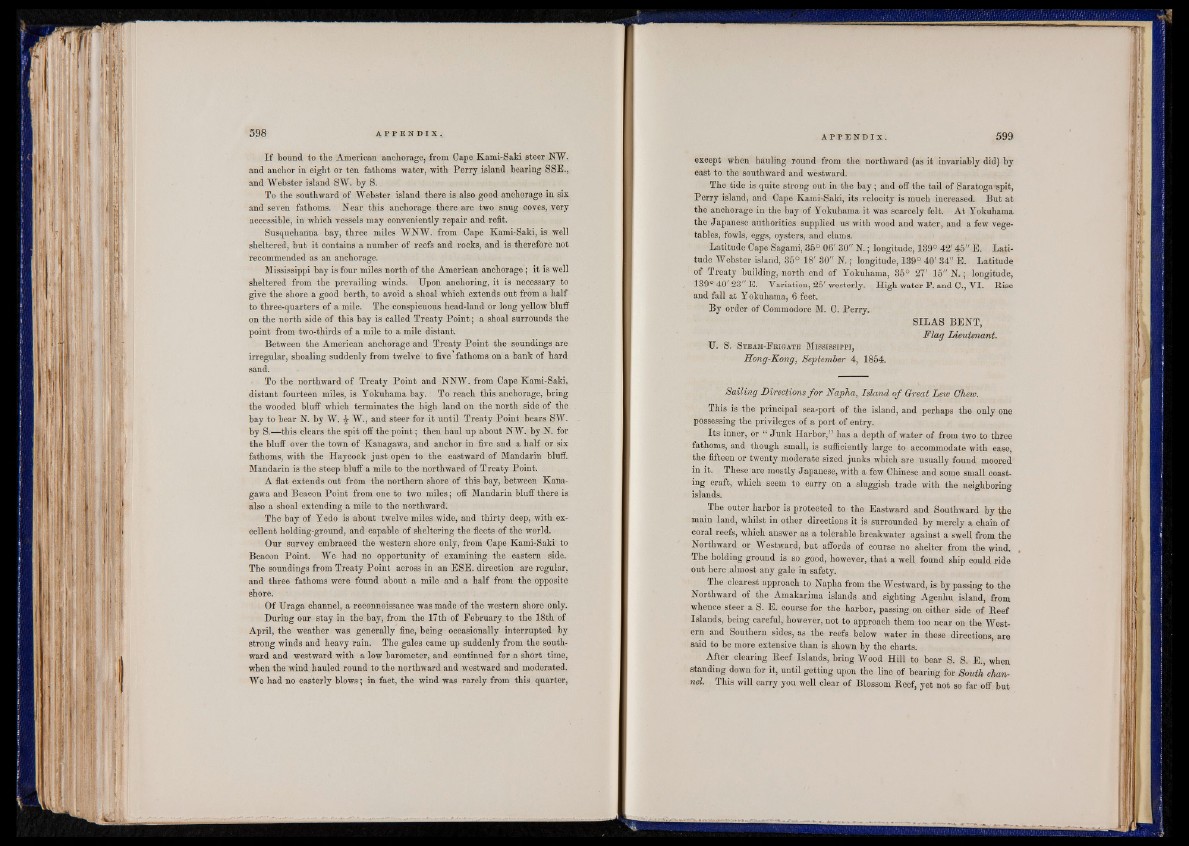
I f bound to the American anchorage, from Cape Kami-Saki steer NW.
and anchor in eight or ten fathoms water, with Perry island bearing SSE.,
and Webster island SW. by S.
To the southward of Webster island there is also good anchorage in six
and seven fathoms. Near this anchorage there are two snug coves, very
accessible, in which vessels may conveniently repair and refit.
Susquehanna bay, three miles WNW. from Cape Kami-Saki, is well
sheltered, but it contains a number of reefs and rocks, and is therefore not
recommended as an anchorage.
Mississippi bay is four miles north of the American anchorage; it is well
sheltered from the prevailing winds. Upon anchoring, it is necessary to
give the shore a good berth, to avoid a shoal which extends out from a half
to three-quarters of a mile. The conspicuous head-land or long yellow bluff
on the north side of this bay is called Treaty Point; a shoal surrounds the
point from two-thirds of a mile to a mile distant.
Between the American anchorage and Treaty Point the soundings are
irregular, shoaling suddenly from twelve to five fathoms on a bank of hard
sand.
To the northward of Treaty Point and NNW. from Cape Kami-Saki,
distant fourteen miles, is Yokuhama bay. To reach this anchorage, bring
the wooded bluff which terminates the high land on the north side of the
bay to bear N. by W. -J- W., and steer for it until Treaty Point bears SW.
by S.—this clears the spit off the point; then haul up about N W. by N. for
the bluff over the town of Kanagawa, and anchor in five and a half or six
fathoms, with the Haycock just open to the eastward of Mandarin bluff.
Mandarin is the steep bluff a mile to the northward of Treaty Point.
A flat extends out from the northern shore of this bay, between Kanagawa
and Beacon Point from one to two miles; off Mandarin bluff there is
also a shoal extending a mile to the northward:
The bay of Yedo is about twelve miles wide, and thirty deep, with excellent
holding-ground, and capable of sheltering the fleets of the world.
Our survey embraced the western shore only, from Cape Kami-Saki to
Beacon Point. We had no opportunity of examining the eastern side.
The soundings from Treaty Point across in an ESE. direction are regular,
and three fathoms were tbund about a mile and a half from the opposite
shore.
Of Uraga channel, a reconnoissance was made of the western shore only.
During our stay in the bay, from the 17th of February to the 18th of
April, the weather was generally fine, being occasionally interrupted by
strong winds and heavy rain. The gales came up suddenly from the southward
and westward with a low barometer, and continued for a short time,
when the wind hauled round to the northward and westward and moderated.
We had no easterly blows; in fact, the wind was rarely from this quarter,
except when hauling round from the. northward (as it invariably did) by
east to the southward and westward.
The tide is quite strong out in the bay; and off the tail of Saratoga 'spit,
Perry island, and Cape Kami-Saki, its velocity is much increased. But at
the anchorage in the bay of Yokuhama it was scarcely felt. At Yokuhama
the Japanese authorities supplied us with wood and water, and a few vegetables,
fowls, eggs, oysters, and clams.
Latitude Cape Sagami, 35° 06' 30" N .; longitude, 139° 42' 45" E. Latitude
Webster island, 35° 18' 30" N. I longitude, 139° 40' 34" E. Latitude
of Treaty building, north end of Yokuhama, 35° 27' 15" N .; longitude,
139° 40'23" E. Yariation, 2 5 'westerly. High water F. and C., YI. Bise
and fall at Y okuhama, 6 feet.
By order of Commodore M. C. Perry.
SILAS BENT,
Flag Lieutenant.
U. S. Steam-Frigate Mississippi,
Hong-Kong, September 4, 1854.
Sailing Directions fo r Napha, Island o f Great Lew Chew.
This is the principal sea-port of the island, and perhaps the only one
possessing the privileges of a port of entry.
Its inner, or “ Junk Harbor,” has a depth of water of from two to three
fathoms, and though small, is sufficiently large to accommodate with ease,
the fifteen or twenty moderate sized junks which are usually found moored
in it. These are mostly Japanese, with a few Chinese and some small coasting
craft, which seem to carry on a sluggish trade with the neighboring
islands.
The outer harbor is protected to the Eastward and Southward by the
main land, whilst in other directions it is surrounded by merely a chain of
coral reefs, which answer as a tolerable breakwater against a swell from the
Northward or Westward, but affords of course no shelter from the wind.
The holding ground is so good, however, that a well found ship could ride
out here almost any gale in safety.
The clearest approach to Napha from the Westward, is bypassing to the
Northward of the Amakarima islands and sighting Agenhu island, from
whence steer a S. E. course for the harbor, passing on either side of Beef
Islands, being careful, however, not to approach them too near on the Western
and Southern sides, as the reefs below water in these directions, are
said to be more extensive than is shown by the charts.
After clearing Beef Islands, bring Wood Hill to bear S. S. E., when
standing down for it, until getting upon the fine of bearing for South channel.
This will carry you well clear of Blossom Beef, yet not so far off but